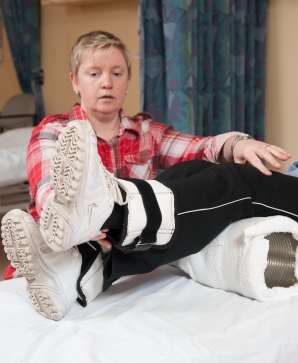A new program implemented at Rouge Valley Health System (RVHS) is helping to reduce readmission rates for patients once they are discharged. Studies have shown that inadequate discharge support contributes to a longer hospital stay, higher risk of negative health outcomes, and readmissions. The Care After The Care in Hospital – or CATCH – program hopes to fix that.
“CATCH focuses on fully understanding and addressing patient needs upon discharge to more adequately respond to the challenge of readmissions rates,” says Amber Curry, manager of the ambulatory care unit, and pre-op clinic, Rouge Valley Ajax & Pickering (RVAP), and fracture clinic, RVHS.
The CATCH program was implemented in November at both Rouge Valley hospital campuses – Rouge Valley Centenary (RVC) and RVAP. It works to improve patient flow by using physicians, nurses and rehabilitation therapists, who to work together to help reduce the patient’s chances of being readmitted for the same medical issue. Their goal is to, ultimately, help the patient return home sooner, and to remain within the community. Patients are referred to CATCH when they are discharged from hospital.
“CATCH helps our patients to better manage their own conditions at home, and to be aware of the supports available to them right here in the community,” explains Aaisha Savvas, manager, complex continuing care, RVC, and outpatient rehab services, RVHS. “We’re empowering our patients by giving them the tools they need to self-manage their conditions, helping to reduce readmissions.”
Interdisciplinary approach
One important element of the program is the interdisciplinary approach between the physician, nurse and physiotherapist in helping to provide the patient with a better ability to manage their condition from in the community. “The physician, nurse and the therapist play a very important and complimentary role in ensuring the patient’s needs get addressed in a more holistic way,” explains Curry.
Physician participation ensures that there is appropriate medical follow-up once the patient is discharged. A general internist, based in the hospital’s general internal medicine clinic, can address any medication concerns or additional testing needs, if required.
Both the nurse and physiotherapist play a role in helping to educate the patient about their condition, so that they will be able to effectively self-manage in the community.
The nurse will assess the patient for different risk factors, including falls, medication, cognition, nutrition and even incontinence. With each of these risk factors, the nurse can develop interventions for individual patient needs. By helping to educate the patient on factors such as proper diet and medication administration, they can teach the patient how these factors can improve their ability to self-manage their condition.
MORE: MUSIC THERAPY AND PATIENT CENTRED CARE
By assessing the patient, the physiotherapist can prescribe an individualized reconditioning program. They can also help to educate the patient on preventing falls and deconditioning, and how to maintain good physical activity in the community.
“After being assessed by the physiotherapist, patients are assisted to achieve their physical and functional goals by a therapy assistant in an individualized, small group format,” says Curry.
The physiotherapist sees patients biweekly and can later assess if more therapy is required, or if they can be referred to less intensive community programs, such as exercise classes.
“We’re beginning to see improvements in the outcomes of our patients in the CATCH program,” explains Savvas. “Patients are able to return to the community in a much better condition, and with improved function.”




